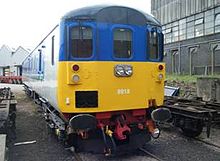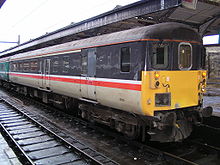- Driving Brake Standard Open
-
British Rail DBSO
DBSO 9701 arriving at Colchester station on 12th June 2003. This vehicles carries Anglia Railways turquoise livery.In service 1979 – Present Manufacturer Originally - BREL Derby
Rebuilt - BREL - GlasgowFamily name British Rail Mark 2 Number built 14 rebuilt Number scrapped 1 Fleet numbers 9701–9714 Operator Network Rail
NI RailwaysSpecifications Car length 66 ft 0 in (20.12 m) Width 9 ft 3 in (2.82 m) Height 12 ft 9 1⁄2 in (3.899 m) Maximum speed 100 mph (160 km/h) Weight 33 long tons (34 t) Braking system(s) Air Gauge 1,435 mm (4 ft 8 1⁄2 in) DBSO 9710 at Norwich station on 31st January 2004. This was the final DBSO to retain InterCity livery.
 DBSO 9710 in 'one' livery at Norwich on 21st April 2004
DBSO 9710 in 'one' livery at Norwich on 21st April 2004
 DBSO 9712 following conversion for use by NI Railways as 8918
DBSO 9712 following conversion for use by NI Railways as 8918
A Driving Brake Standard Open or DBSO is a type of railway carriage, converted to operate as a control car. Fourteen such vehicles, numbered 9701 to 9714, were converted from Mk. 2F Brake Standard Open (standard class coaches with brake van) carriages. Modifications included adding a driving cab and TDM equipment to allow a locomotive to be driven remotely. Using a system known as push-pull, the driver in the DBSO can drive the locomotive, even though it is at the rear of the train.
Operations
The vehicles converted in two batches. Numbers 9701–9710 were converted in 1979 for use on the newly introduced Glasgow-Edinburgh InterCity ScotRail push-pull service with specially modified Class 47/7 locomotives. A further four, nos. 9711–9714 were converted in the period 1985–1986. The fourteenth DBSO, no. 9714 was a replacement for no. 9706, which was derailed and damaged beyond repair in the Polmont rail crash after it hit a cow.
When first introduced, the DBSO fleet had half-cabs and retained their end gangways. They were later rebuilt to have full-width cabs, with the removal of the end gangways.
In the late 1980s, with the introduction of Class 158 diesel multiple units on the Glasgow-Edinburgh corridor, the DBSO fleet was transferred en-masse, and converted to use the TDM system used by the AC electric locomotives used on the London Liverpool Street-Norwich services on the newly electrified Great Eastern Main Line. The Mk. 2E/2F coaching stock used on the route was based at Norwich Crown Point and rakes were marshalled into semi-permanent formations (numbered AR01-AR13). Traction was provided by Class 86/2 electric locomotives.
Following privatisation of the British Rail, the London-Norwich route became part of the Anglia Railways franchise. From 1997 onwards, a new livery of turquoise with a white stripe was introduced onto all Anglia stock. However, rake AR01, containing DBSO 9710 retained its old InterCity livery.
In April 2004, the Anglia franchise became part of the new 'one' franchise. The thirteen surviving DBSOs were still in service, although they were gradually replaced by Driving Van Trailers (DVT) cascaded from Virgin Trains. One DBSO, no. 9710, has had the new 'one' Anglia livery applied by means of adhesive vinyls, whilst retaining the InterCity livery underneath.
However, many of the new Mark 3 sets being received by Anglia were not originally accompanied by DVTs. For this reason a small number of DBSOs were retained until enough DVTs had been received. The last DBSOs were withdrawn from mainline service in December 2006. Some vehicles will probably see further use by charter operators, with no. 9713 already moving to Crewe for assessment by Riviera Trains. Two others, nos. 9704 and 9709 moved for storage with FM Rail, but since this company's collapse have been moved for secure storage. In addition, one unspecified DBSO has been reserved for preservation by the Railway Heritage Committee.
In February 2007, Network Rail took delivery of five DBSOs, nos. 9701, 9702, 9703, 9708 and 9714. These will be converted to allow test-trains to run in push-pull mode, therefore eliminating the need to operate two locomotives (one at each end of the train).
ex Riviera/Anglia MK2 driving trailer 9712 was sold to Northern Ireland Railways for use on the ex Gatwick set to convert it to push-pull operation using 111 class locomotives. It is 8918 on NIR The vehicle was finally delivered to Belfast on June 26, 2009. Almost 14 months late on contracted delivery date. It now looks as if the vehicle will never run on NIR as the ex Gatwick coaches were stopped on June 19th (before it was delivered!) and have now been withdrawn.
Fleet details
Full details of the DBSO fleet are given below:
Key: In Service Withdrawn Under repair Scrapped Numbers Built Converted Current/Final Livery Operator Withdrawn Status DBSO BSO 9701 9528 1974 Derby 1979 Glasgow NR Yellow Network Rail Operational In Service with Network Rail 9702 9510 1974 Derby 1979 Glasgow NR Yellow Network Rail Operational In Service with Network Rail 9703 9517 1974 Derby 1979 Glasgow NR Yellow Network Rail Operational In Service with Network Rail 9704 9512 1974 Derby 1979 Glasgow Anglia Railways FM Rail 07/2006 Secure storage at MoD Long Marston 9705 9519 1974 Derby 1979 Glasgow Anglia Railways ’one’ 01/2006 Secure storage at MoD Kineton 9706 9514 1974 Derby 1979 Glasgow InterCity ScotRail British Rail 11/1984 Scrapped following accident 9707 9511 1974 Derby 1979 Glasgow Anglia Railways ’one’ 01/2006 Secure storage at MoD Kineton 9708 9530 1974 Derby 1979 Glasgow NR Yellow Network Rail Operational In Service with Network Rail 9709 9515 1974 Derby 1979 Glasgow Anglia Railways FM Rail 07/2006 Secure storage at MoD Long Marston 9710 9518 1974 Derby 1979 Glasgow ’one’ ’one’ 08/2005 Secure storage at Eastleigh 9711 9532 1974 Derby 1985 Glasgow Anglia Railways ’one’ 12/2006 Secure storage at MoD Kineton 9712 9534 1974 Derby 1985 Glasgow Translink Gatwick NI Railways 04/2006 At York Road Depot, Belfast 9713 9535 1974 Derby 1985 Glasgow Anglia Railways Riviera Trains 01/2006 Under repair at Crewe Carriage Shed 9714 9536 1974 Derby 1986 Glasgow NR Yellow Network Rail Operational In Service with Network Rail Coaching stock of British Rail Passenger coaches Mark 2:BFO · CO · FO · RFM · SLE · SLED · SLEP · TSO · TSOB - (Locomotive hauled)
TF · TGS · TRB · TRFB · TRFK · TRSB · TS - (InterCity 125 trailers)Other Mark 1:Categories:- British Rail coaching stock
- BREL products
Wikimedia Foundation. 2010.


